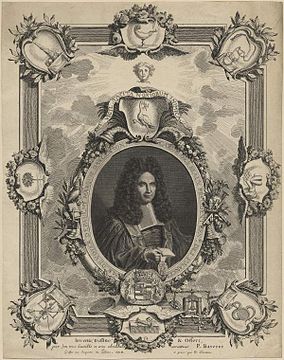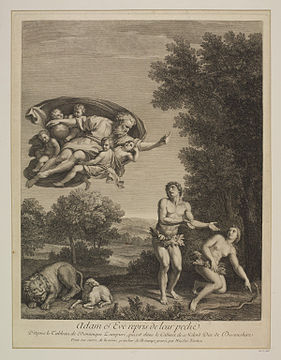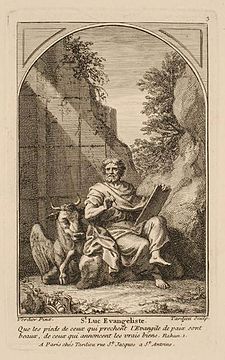
Alexis Simon Belle was a French portrait painter, known for his portraits of the French and Jacobite nobility. As a portrait artist, Belle's style followed that of his master François de Troy, Hyacinthe Rigaud, and Nicolas de Largillière. He was the master of the painter Jacques-André-Joseph-Camelot Aved (1702–1766).

Charles-Nicolas Cochin was a French engraver, designer, writer, and art critic. To distinguish him from his father of the same name, he is variously called Charles-Nicolas Cochin le Jeune, Charles-Nicolas Cochin le fils, or Charles-Nicolas Cochin II.

Louise-Magdeleine Horthemels, or Louise-Madeleine Hortemels, also called Magdeleine Horthemels, was a French engraver, the mother of Charles-Nicolas Cochin. She is also sometimes credited under her married name of Louise Madeleine Cochin or Madeleine Cochin.

Louis Pierre Henriquel-Dupont was a French engraver. His students included Charles Bellay, Jean-Baptiste Danguin, Adrien Didier, Alphonse and Jules François, Adolphe-Joseph Huot, Achille and Jules Jaquet, Jules Gabriel Levasseur, Aristide Louis, Louis Marckl, Isidore-Joseph Rousseaux, Abel Mignon and Charles Albert Waltner.
Bernard Baron was a French engraver and etcher who spent much of his life in England.

Jacques-Philippe Le Bas, or Lebas was a French engraver, head of the largest engraving workshop in Paris during the 18th century.

Charles Nicolas Cochin the Elder was a French line-engraver.

Jean-Louis Anselin was a French engraver. Amongst his best work is an engraved portrait of Madame Pompadour as "La Belle Jardinière" (pictured).
Gaspard Duchange (1662–1757) was a French engraver.

Jacques-Nicolas Tardieu, called "Tardieu fils" or "Tardieu the younger", was a French engraver.

François-Alexandre Verdier was French painter, draftsman and engraver. He was a student and assistant of Charles Le Brun.

Pierre-Simon-Benjamin Duvivier was a French engraver of coins and medals.
Marie-Anne-Hyacinthe Horthemels was a French engraver, wife of the King's engraver Nicolas-Henri Tardieu.
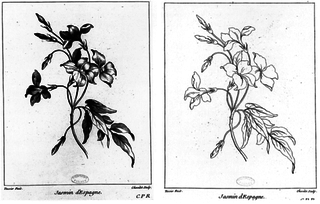
Juste Chevillet (1729–1802) was a French engraver. He is known for his engravings for the Histoire Naturelle of Georges-Louis Leclerc, Comte de Buffon.

Gilles Demarteau or Gilles Demarteau the Elder was an etcher, engraver and publisher who was active in Paris for his entire career. He is one of the persons to whom has been attributed the invention of the crayon manner of engraving. He is recognized as playing an important role in the development of this engraving technique. He was one of the key reproductive engravers and publishers of the work of François Boucher.
Renée-Élisabeth Marlié was an 18th-century French engraver.

Christine Antoinette Charlotte Desmares, professionally known as Mlle Desmares, was a French stage actress. Scion of a notable comic actor family, she had an active stage career that spanned three decades, performing with the Comédie-Française from 1699 until her retirement in 1721; she was also remembered as a mistress of Philippe II, Duke of Orléans, Regent of France.
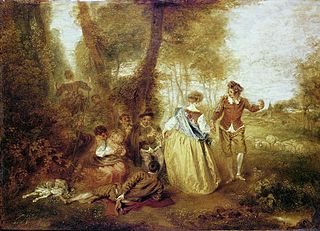
Pastoral Pleasure is a c. 1714–1716 fête galante painting by Antoine Watteau, now in the Musée Condé in Chantilly. Two other Watteau paintings survive with extremely similar compositions - the largest and most finished is The Shepherds, now in the Charlottenburg Palace, Berlin; another painting of that composition, once owned by Georges Wildenstein, seems to be a reworking of the Charlottenburg painting. Pierre Rosenberg argues that the Chantilly painting was an oil sketch for the Charlottenburg one. Three other copies of the Chantilly version appeared in 19th and 20th century auctions, but their locations are now unknown.

The Perfect Accord, also adapted into English as Perfect Harmony, is a 1719 painting by Antoine Watteau, now in the Los Angeles County Museum of Art. It was the pendant to the same artist's The Surprise.

Two Studies of an Actor is the name given to a sheet of drawings in the trois crayons technique by the French Rococo artist Antoine Watteau. Dated between 1716 and 1721, the sheet was once in the collection of Watteau's friend, the manufacturer and publisher Jean de Jullienne; passing through a number of private collectors, it was acquired in 1874 by the Kupferstichkabinett, Berlin, where it remains.




